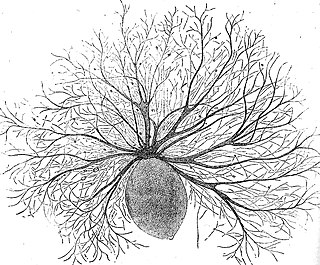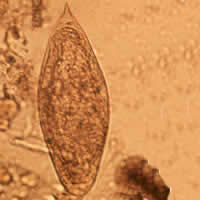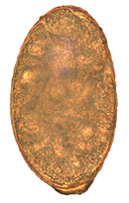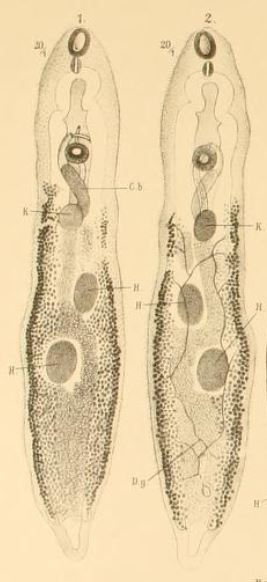
Acanthocephala is a group of parasitic worms known as acanthocephalans, thorny-headed worms, or spiny-headed worms, characterized by the presence of an eversible proboscis, armed with spines, which it uses to pierce and hold the gut wall of its host. Acanthocephalans have complex life cycles, involving at least two hosts, which may include invertebrates, fish, amphibians, birds, and mammals. About 1420 species have been described.

Gobiidae or gobies is a family of bony fish in the order Gobiiformes, one of the largest fish families comprising more than 2,000 species in more than 200 genera. Most of gobiid fish are relatively small, typically less than 10 cm (3.9 in) in length, and the family includes some of the smallest vertebrates in the world, such as Trimmatom nanus and Pandaka pygmaea, Trimmatom nanus are under 1 cm long when fully grown, then Pandaka pygmaea standard length are 9 mm (0.35 in), maximum known standard length are 11 mm (0.43 in). Some large gobies can reach over 30 cm (0.98 ft) in length, but that is exceptional. Generally, they are benthic or bottom-dwellers. Although few are important as food fish for humans, they are of great significance as prey species for other commercially important fish such as cod, haddock, sea bass and flatfish. Several gobiids are also of interest as aquarium fish, such as the dartfish of the genus Ptereleotris. Phylogenetic relationships of gobiids have been studied using molecular data.

Sarcoptes scabiei or the itch mite is a parasitic mite that burrows into skin and causes scabies. The mite is found in all parts of the world. Humans are not the only mammals that can become infected. Other mammals, such as wild and domesticated dogs and cats as well as ungulates, wild boars, bovids, wombats, koalas, and great apes are affected.

Monogeneans, members of the class Monogenea, are a group of ectoparasitic flatworms commonly found on the skin, gills, or fins of fish. They have a direct lifecycle and do not require an intermediate host. Adults are hermaphrodites, meaning they have both male and female reproductive structures.
Hymenolepiasis is infestation by one of two species of tapeworm: Hymenolepis nana or H. diminuta. Alternative names are dwarf tapeworm infection and rat tapeworm infection. The disease is a type of helminthiasis which is classified as a neglected tropical disease.
Gnathostomiasis, also known as larva migrans profundus, is the human infection caused by the nematode Gnathostoma spinigerum and/or Gnathostoma hispidum, which infects vertebrates.

Anisakis is a genus of parasitic nematodes that have life cycles involving fish and marine mammals. They are infective to humans and cause anisakiasis. People who produce immunoglobulin E in response to this parasite may subsequently have an allergic reaction, including anaphylaxis, after eating fish infected with Anisakis species.

Velvet disease is a fish disease caused by dinoflagellate parasites of the genera Amyloodinium in marine fish, and Oodinium in freshwater fish. The disease gives infected organisms a dusty, brownish-gold color. The disease occurs most commonly in tropical fish, and to a lesser extent, marine aquaria.

Schistosoma intercalatum is a parasitic worm found in parts of western and central Africa. There are two strains: the Lower Guinea strain and the Zaire strain. S. intercalatum is one of the major agents of the rectal form of schistosomiasis, also called bilharzia. It is a trematode, and being part of the genus Schistosoma, it is commonly referred to as a blood-fluke since the adult resides in blood vessels.

The common goldfish is a breed of goldfish and a family of Cyprinidae of order cypriniforms. Goldfish are a form of domesticated wild carp and are a close relative of koi. Most varieties of fancy goldfish were derived from this simple breed. Common goldfish come in a variety of colors including red, orange, red/white, white/black, yellow/white, blue, grey/brown, olive green, yellow, white, and black, with the most common variation being orange, hence the name. Sometimes, the brightness, duration, and vividness of the color may be an indication of the fish's health status, but not always, as manifold waters conditions facilitate the apparent discoloration.

Sea lice are copepods of the family Caligidae within the order Siphonostomatoida. They are marine ectoparasites that feed on the mucus, epidermal tissue, and blood of host fish. The roughly 559 species in 37 genera include around 162 Lepeophtheirus and 268 Caligus species.
Trichostrongylus tenuis, also known as the strongyle worm, is a gut nematode found in the United Kingdom, sensitive to Pyrantel pamoate. Larvae have a short migration inside the mucosa of the intestine and return quickly to the digestive tract.

Cestoda is a class of parasitic worms in the flatworm phylum (Platyhelminthes). Most of the species—and the best-known—are those in the subclass Eucestoda; they are ribbon-like worms as adults, known as tapeworms. Their bodies consist of many similar units known as proglottids—essentially packages of eggs which are regularly shed into the environment to infect other organisms. Species of the other subclass, Cestodaria, are mainly fish infecting parasites.

The salmon louse is a species of copepod in the genus Lepeophtheirus. It is a sea louse, a parasite living mostly on salmon, particularly on Pacific and Atlantic salmon and sea trout, but is also sometimes found on the three-spined stickleback. It feeds on the mucus, skin and blood of the fish. Once detached, they can be blown by wind across the surface of the sea, like plankton. When they encounter a suitable marine fish host, they adhere themselves to the skin, fins, or gills of the fish, and feed on the mucus or skin. Sea lice only affect fish and are not harmful to humans.

Nanophyetus salmincola is a food-borne intestinal trematode parasite prevalent on the Pacific Northwest coast. The species may be the most common trematode endemic to the United States.

Lernaeocera branchialis, sometimes called cod worm, is a parasite of marine fish, found mainly in the North Atlantic. It is a marine copepod which starts life as a small pelagic crustacean larva. It is among the largest of copepods, ranging in size from 2 to 3 millimetres when it matures as a copepodid larva to more than 40 mm as a sessile adult.

Oxyjulis californica is a species of wrasse native to the eastern Pacific Ocean along the coasts of California and Baja California. Its distribution extends from Salt Point in Sonoma County, California, to southern central Baja California, near Cedros Island. It is a very common species; its common name in Spanish is señorita.
Eustrongylidosis is a parasitic disease that mainly affects wading birds worldwide; however, the parasite's complex, indirect lifecycle involves other species, such as aquatic worms and fish. Moreover, this disease is zoonotic, which means the parasite can transmit disease from animals to humans. Eustrongylidosis is named after the causative agent Eustrongylides, and typically occurs in eutrophicated waters where concentrations of nutrients and minerals are high enough to provide ideal conditions for the parasite to thrive and persist. Because eutrophication has become a common issue due to agricultural runoff and urban development, cases of eustrongylidosis are becoming prevalent and hard to control. Eustrongylidosis can be diagnosed before or after death by observing behavior and clinical signs, and performing fecal flotations and necropsies. Methods to control it include preventing eutrophication and providing hosts with uninfected food sources in aquaculture farms. Parasites are known to be indicators of environmental health and stability, so should be studied further to better understand the parasite's lifecycle and how it affects predator-prey interactions and improve conservation efforts.
Gyrodactylus turnbulli is an ectoparasite from the class Monogenea, is part of the phylum Platyhelminthes, and from the genus Gyrodactylus. It only requires one host to transmit an infection; however, since this parasite lacks oncomiracidium, it must rely on either the adult or subadult for spread of infection. Found in freshwater, this flatworm is commonly found on the gills and fins of the guppy, Poecilia reticulata. G. turnbulli was said to be host specific, but an experiment where parasitologists artificially infected guppies suggests that the parasite can infect a wider range of species. This ability is achievable by host switching, which promotes speciation.

Trematoda is a whole-living worm that lives in different parts of the host's body, some of which live in bile ducts. These are called hepatic worms such as Fasciola species, including species that live in the intestines such as the genus Heterophyes, including those living in blood vessels such as the genus that causes schistosomiasis, the genus of Schistosoma. Including what lives in the lung such as the genus of Paragonimus.

















